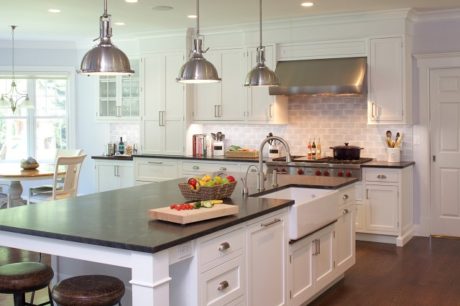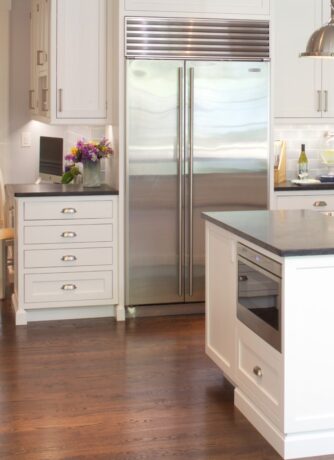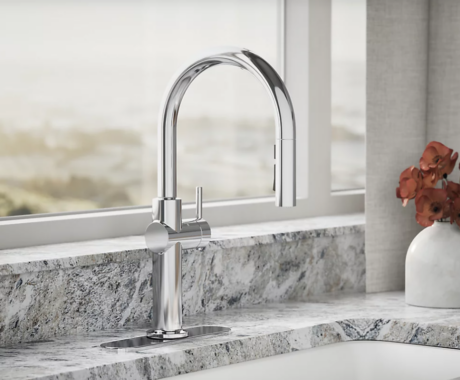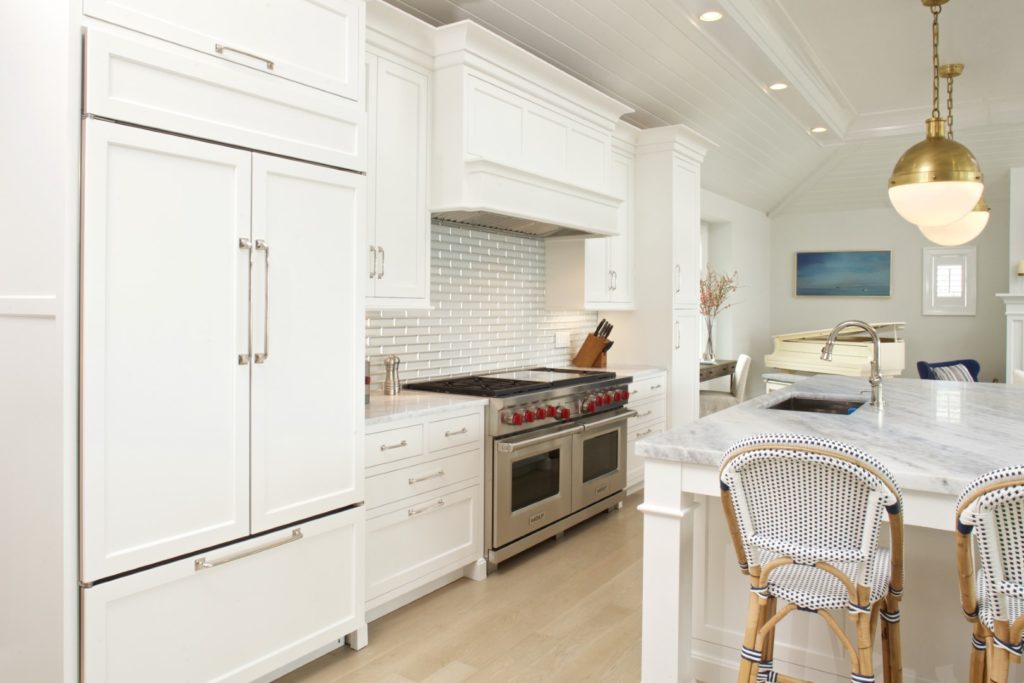SaftDesigning an Aging-in-Place Kitchen: Safe, Functional, and Beautiful Solutions
A well-planned aging-in-place kitchen design ensures that your work triangle—made up of the oven, sink, and refrigerator—makes daily tasks easier and more efficient as you age. Keeping these three key appliances close together, ideally on the same level, will improve flow and reduce unnecessary movement. If needed, consider installing a secondary sink for added convenience. An effective aging-in-place kitchen design helps you easily transfer food, pots, and baking pans between zones.
When selecting appliances, choose models that are easy to use, easy to read, and have large, intuitive buttons. As we age, the risk of burns and injuries increases, so it’s crucial to incorporate features that promote safety. Fortunately, manufacturers are developing appliances and faucets that reduce hazards in the kitchen.
1. The Importance of the Work Triangle for Aging in Place

A thoughtfully designed work triangle—connecting the sink, oven, and refrigerator—makes kitchen tasks easier and more efficient. For an aging-in-place kitchen, keep these three core elements as close together as possible to minimize steps and reduce fatigue.
✅ If space allows, consider adding a secondary sink near the cooking area or prep zone for added convenience.
✅ Keep these appliances and fixtures on the same level to ease the transfer of pots, baking trays, and food.
✅ Always select easily read, operate, and clean appliances. Look for models with large buttons, clear displays, and intuitive controls.
2. Oven Safety: Innovations for Aging-in-Place
As we age, the risk of burns from hot surfaces increases. Fortunately, manufacturers have developed safer oven designs that reduce the risk of injury.
👉 French-door or side-opening wall ovens—available from GE, Viking, and Bosch—eliminate the need to reach over a hot oven door, significantly improving safety.
✅ Place wall ovens at a comfortable, ergonomic height: waist-high for some users, or lower if needed.
✅ Include a landing surface next to or across from the oven—this is required by building code and offers a safe spot for hot dishes.
✅ For extra safety, install a pullout shelf beneath the oven. This simple feature provides a place to set a heavy pan directly below the oven door, reducing the need to carry hot items across the kitchen.
3. Cooktop Considerations: Choosing Safer Options for Aging in Place
When it comes to cooktops, safety and ease of use are key when designing a kitchen for aging in place. Electric cooktops are generally considered safer than gas for aging-in-place designs, eliminating the risk of an open flame.
✅ Induction cooktops are an excellent alternative to gas, heating the pan while keeping the surface cool and reducing the chance of accidental burns.
✅ Always select cooktops with front-mounted controls to avoid reaching over hot burners.
✅ Choose a model with clear indicators to show when a burner is on or off.
4. Microwave Placement for Safety and Comfort for Aging in Place

Microwave placement can make or break kitchen safety for older adults who are aging in place. Microwaves should be positioned at or near counter height to avoid dangerous bending or reaching.
✅ One of the best solutions is a microwave drawer from brands like Sharp, Jenn-Air, and KitchenAid.
✅ Although typically installed slightly below counter height, microwave drawers are easier to use safely than standard hinged-door models.
5. Reducing the Risk of Scald Burns for Aging in Place
Scald injuries are a common hazard in the kitchen, especially among older adults. In fact, the Consumer Product Safety Commission (CPSC) reports that 42% of scald injuries are caused by hot food, and 32% by hot water.
Here are two simple ways to reduce this risk:
✅ Locate a sink close to the cooktop for easy access to water when cooking.
✅ Install a pot filler faucet at the cooktop to eliminate the need to carry heavy, hot water across the kitchen.
✅ Consider using pasta pots with built-in lift-out strainers to reduce handling of boiling water.
✅ Lower your water heater temperature to 120°F (the CPSC’s recommended maximum) to reduce the risk of burns from hot water.
6. Faucet Safety Features For Aging in Place

Designing the right kitchen faucet can make daily tasks much easier for individuals with arthritis or limited mobility when aging in place.
✅ Hands-free faucets or touch-activated faucets are highly recommended for aging-in-place kitchens.
✅ Be sure to include an anti-scald device on all faucets to prevent burns from hot water.
✅ For added safety, consider placing the faucet to the side of the sink rather than the traditional center location—this helps avoid reaching over hot pans or getting too close to a stream of hot water.
7. Refrigerators and Accessible Kitchen Storage
A side-by-side refrigerator/freezer is often the most straightforward style for seniors aging in place, reducing the need to bend or stretch.
✅ Look for models with ample door storage for heavier items like milk and juice.

✅ Opt for refrigerators with pull-out shelves or drawers to make seeing and reaching food items easier.
Other helpful modifications for an aging-in-place kitchen design include:
-
Under-cabinet lighting for better visibility
-
Rounded countertop edges to reduce injury risk
-
Non-slip flooring to minimize fall hazards
-
Easy-to-clean surfaces to simplify maintenance
8. Cabinet and Fixture Planning for Aging-in-Place Kitchens
Don’t overlook cabinetry and fixtures when planning an aging-in-place kitchen design. Opt for pull-out shelves, D-shaped handles, and soft-close mechanisms to improve ease of use and accessibility. Install lever-style faucets rather than knobs to reduce strain on wrists and hands. Lighting is equally important—incorporate task lighting under cabinets to illuminate work areas and reduce shadows.
Improving your kitchen’s functionality doesn’t have to happen all at once. Many updates can be made gradually as needs evolve. Whether planning a complete renovation or making strategic kitchen design upgrades, each choice brings you closer to a beautiful kitchen that’s beautiful today and functional for the future.
A well-designed aging-in-place kitchen helps maintain independence, safety, and joy in daily living, without sacrificing style.
Let JWH Design & Cabinetry Help You Plan for the Future
At JWH Design & Cabinetry, great kitchen design combines beautiful form with thoughtful function. If you’re considering an adaptive kitchen renovation—or want to future-proof your current home—we’re here to help.
📞 Contact us today to discuss your project or schedule a design consultation.
👉 Follow us on Instagram @jwhdesigns for inspiration and ideas.
We’d love to help you create a kitchen that works for you today, tomorrow, and for years.
— Jennifer Howard, Owner + Principal Designer, JWH Design & Cabinetry
